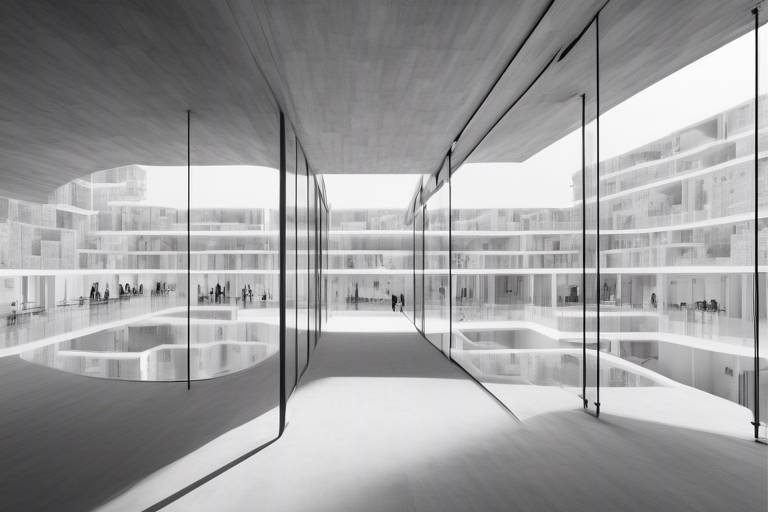The Role of AI in Architecture
In recent years, the architectural landscape has experienced a seismic shift, largely driven by the advent of artificial intelligence (AI). This technology is not just a buzzword; it is a powerful tool that is reshaping how architects design and construct buildings. Imagine walking into a world where your design ideas are not limited to your imagination but are expanded by algorithms that can simulate real-world scenarios. That's the promise of AI in architecture!
AI is enhancing design processes, improving efficiency, and fostering innovation in building practices and sustainability. It’s like having a supercharged assistant that can analyze vast amounts of data, predict outcomes, and offer creative solutions that might never have crossed your mind. For architects, this means more time to focus on creativity while AI handles the heavy lifting of data analysis and design optimization.
As we dive deeper into this transformative journey, we’ll explore how AI-driven design tools are revolutionizing the field, the exciting realm of generative design techniques, the integration of smart materials, and the role of AI in promoting sustainability. With these advancements, the future of architecture looks not only innovative but also more environmentally conscious.
Consider the possibilities: what if buildings could adapt to their environment, becoming energy-efficient in real-time? Or imagine a scenario where project management is so streamlined that construction timelines are reduced significantly, allowing for quicker occupancy. These are not just dreams; they are becoming a reality thanks to AI.
In the following sections, we will uncover the nuances of AI in architecture, breaking down complex concepts into relatable insights. We’ll also address some common questions and concerns surrounding this technology, ensuring that you walk away not only informed but also inspired by the potential of AI in shaping the future of our built environment.

AI-Driven Design Tools
In the ever-evolving world of architecture, AI-powered design tools are not just a trend; they are a game-changer. Imagine having a virtual assistant that can sift through countless design possibilities in seconds, offering you options that align perfectly with your vision. This is the magic of AI in architecture. By leveraging advanced algorithms and machine learning, architects can now create structures that are not only aesthetically pleasing but also incredibly functional and efficient.
These tools enhance the design process by automating repetitive tasks, allowing architects to focus on the creative aspects of their projects. For instance, AI can analyze historical data from previous projects to suggest design elements that have proven successful in similar contexts. This means architects can make informed decisions faster than ever before, leading to a more streamlined workflow.
One of the standout features of AI-driven design tools is their ability to facilitate collaborative design efforts. With cloud-based platforms, teams can work together in real-time, regardless of their physical locations. This not only fosters creativity but also ensures that everyone is on the same page, reducing the chances of miscommunication and errors. Imagine a team of architects, engineers, and designers all contributing their expertise to a project simultaneously, with AI synthesizing their input into a cohesive design. It’s like having a digital roundtable where the best ideas rise to the top!
Moreover, these tools can generate a multitude of design options based on specific parameters set by the architect. For example, if an architect specifies certain materials, dimensions, and environmental factors, the AI can produce various design iterations that meet those criteria. This is akin to having a brainstorming session with thousands of ideas at your fingertips, allowing for exploration of creative possibilities that might not have been considered otherwise.
However, it’s essential to acknowledge that while AI-driven design tools offer immense potential, they also come with their own set of challenges. The technology requires a certain level of familiarity and expertise, which means architects need to invest time in learning how to use these tools effectively. Additionally, there’s the question of trust—how much do we rely on AI to make design decisions? Striking a balance between human creativity and machine efficiency is crucial.
As we look towards the future, it's clear that AI-driven design tools will continue to evolve, becoming more intuitive and integrated into the architectural workflow. They are paving the way for a new era of design where the possibilities are truly limitless. So, whether you're an architect looking to enhance your practice or a client eager for innovative solutions, embracing AI in design is not just wise; it's essential.
- What are AI-driven design tools? AI-driven design tools are software applications that use artificial intelligence to assist architects in the design process, offering features like automation, data analysis, and collaborative capabilities.
- How do these tools improve efficiency? By automating repetitive tasks and providing data-driven insights, AI tools enable architects to focus more on creativity and less on mundane tasks, thus speeding up the design process.
- Are there any challenges to using AI in architecture? Yes, challenges include a learning curve for architects and the need to balance human creativity with machine-generated suggestions.

Generative Design Techniques
Generative design is nothing short of a game-changer in the world of architecture. Imagine a scenario where architects can input their design goals and constraints into a system, and in return, receive a plethora of design options that they might not have considered. This is the essence of generative design. By utilizing advanced algorithms, architects can explore an expansive range of creative possibilities, optimizing both aesthetics and functionality in their projects.
At its core, generative design involves the use of computational algorithms that analyze various parameters such as materials, cost, environmental impact, and structural integrity. The result? A multitude of design alternatives that are tailored to meet specific requirements. This process not only accelerates the design phase but also enhances innovation, allowing architects to push the boundaries of traditional design methods.
One of the most exciting aspects of generative design is its ability to foster collaboration among architects, engineers, and clients. By visualizing numerous design options, teams can engage in more productive discussions, leading to decisions that are informed by data rather than intuition alone. This collaborative approach can drastically reduce the time spent in the design phase, allowing projects to move forward more efficiently.
Delving deeper into generative design, we encounter parametric modeling. This technique allows architects to define specific parameters and constraints within their designs. Think of it as setting the rules of a game. Once these rules are established, AI can dynamically adjust and optimize the designs based on real-time feedback. This flexibility means that architects can easily modify designs in response to changing project requirements or client preferences, leading to more adaptable and efficient architectural solutions.
The benefits of parametric design are manifold. Some key advantages include:
- Increased Flexibility: Architects can quickly adapt their designs to meet new requirements or constraints.
- Improved Collaboration: Teams can work together more effectively by visualizing multiple design options.
- Rapid Iteration: The ability to quickly iterate designs leads to better project outcomes and reduced costs.
However, it’s not all smooth sailing. The implementation of parametric design does come with its challenges. For instance, the learning curve can be steep, as architects and designers must familiarize themselves with complex software and computational techniques. Additionally, there is often a need for advanced computational skills, which may not be readily available in all architectural firms. Despite these challenges, the potential rewards of parametric design make it a worthwhile investment for many in the field.
In conclusion, generative design techniques, particularly through the lens of parametric modeling, are revolutionizing the architecture industry. They empower architects to explore new creative avenues while enhancing collaboration and efficiency. As technology continues to evolve, we can only anticipate even more exciting developments in this realm.

Parametric Modeling
Parametric modeling is a groundbreaking approach in architecture that allows designers to create complex forms and structures with remarkable efficiency. By defining specific parameters and constraints, architects can leverage the power of AI to adjust and optimize their designs dynamically. Imagine being able to create a building that not only looks stunning but also adapts to its environment and the needs of its occupants. This is the magic of parametric modeling!
At its core, parametric modeling functions like a set of instructions for a highly intelligent assistant. Architects input various variables—such as dimensions, materials, and environmental factors—and the AI generates multiple design options based on these inputs. This process is akin to having a conversation with a friend who helps brainstorm ideas while ensuring that the final outcome aligns with your vision. It opens up a world of possibilities, allowing architects to explore creative avenues that they might not have considered otherwise.
One of the standout features of parametric modeling is its adaptability. As project requirements evolve, architects can easily modify the parameters, and the AI will reconfigure the design accordingly. This flexibility is invaluable in today’s fast-paced construction environment, where changes can happen on a dime. For example, if a client decides to change the layout of a space, the architect can simply adjust the parameters, and the AI will produce an updated design in no time.
However, the benefits of parametric modeling extend beyond just flexibility. It also fosters improved collaboration among project teams. When multiple stakeholders are involved, having a visual representation of design changes makes it easier to communicate ideas and gather feedback. This collaborative environment is essential for ensuring that everyone is on the same page, ultimately leading to better project outcomes.
To illustrate the impact of parametric modeling, consider the following table that highlights some key advantages:
| Benefit | Description |
|---|---|
| Increased Flexibility | Easy adjustments to design parameters based on evolving project needs. |
| Improved Collaboration | Enhanced communication among team members through visual design iterations. |
| Rapid Iteration | Quickly generate and evaluate multiple design options, saving time and costs. |
| Optimized Performance | AI-driven adjustments lead to more efficient and effective architectural solutions. |
Despite its many advantages, parametric modeling does come with its own set of challenges. For one, there is often a steep learning curve associated with mastering the software and understanding the underlying principles. Architects and designers may need to invest time in acquiring advanced computational skills to fully leverage the potential of parametric design. However, the rewards can be significant, making the effort worthwhile.
In summary, parametric modeling is revolutionizing the architectural landscape by providing architects with the tools to create more adaptable, collaborative, and efficient designs. As technology continues to advance, we can only imagine the incredible structures that will emerge from this innovative approach.

Benefits of Parametric Design
Parametric design is not just a buzzword; it’s a revolutionary approach that is reshaping the architectural landscape. One of the most significant benefits of parametric design is its ability to offer increased flexibility. Architects can set parameters and constraints, which allows for quick adjustments and modifications during the design process. Imagine being able to tweak a building's shape or size with just a few clicks, rather than starting from scratch! This flexibility fosters a more dynamic design environment where creativity can flourish.
Another remarkable advantage is the improved collaboration it encourages among team members. With parametric tools, various stakeholders can visualize changes in real-time, making it easier to communicate ideas and resolve conflicts. This collaborative spirit often leads to more innovative solutions and a design that better meets the needs of the client and the community.
Moreover, parametric design significantly enhances the iteration speed. In traditional design processes, making changes can be time-consuming and labor-intensive. However, with parametric modeling, architects can quickly explore a multitude of design options, evaluate their performance, and refine their choices. This rapid iteration not only saves time but also leads to better project outcomes, as architects can focus on what truly works.
Additionally, the cost-effectiveness of parametric design cannot be overstated. By optimizing designs and reducing the likelihood of errors during the construction phase, architects can save substantial amounts of money. This financial efficiency often translates into lower project costs for clients, making high-quality design more accessible.
However, it’s essential to note that while parametric design offers numerous benefits, it does come with its own set of challenges. The learning curve can be steep, and architects may need to acquire advanced computational skills to fully harness its potential. Yet, the rewards often outweigh the initial hurdles, making it a worthwhile investment in the future of architecture.
In summary, the benefits of parametric design include:
- Increased Flexibility: Quick adjustments and modifications during the design process.
- Improved Collaboration: Real-time visualization fosters better communication.
- Rapid Iteration: Fast exploration of multiple design options enhances creativity.
- Cost-Effectiveness: Optimized designs lead to reduced project costs.
As we continue to embrace technology in architecture, it's clear that parametric design is paving the way for a more efficient, collaborative, and innovative future.
Q1: What is parametric design?
A1: Parametric design is a process that uses algorithms and parameters to create and adjust architectural designs dynamically, allowing for greater flexibility and optimization.
Q2: How does parametric design improve collaboration?
A2: It allows team members to visualize changes in real-time, making it easier to communicate ideas and resolve conflicts effectively.
Q3: What are the challenges of using parametric design?
A3: The main challenges include a steep learning curve and the need for advanced computational skills among architects and designers.

Challenges of Parametric Design
While parametric design offers exciting possibilities for architects, it also comes with its own set of challenges that can be daunting. One of the primary hurdles is the steep learning curve associated with mastering parametric software. Architects accustomed to traditional design methods may find themselves overwhelmed by the complexity of algorithms and computational thinking required to harness the full potential of parametric tools. This transition can feel like learning a new language, where every term and function is foreign at first.
Moreover, the necessity for advanced computational skills cannot be overstated. Architects must not only be creative visionaries but also adept at understanding and manipulating data. This dual requirement can create a gap in the workforce, where those who are proficient in technology may not have the same level of design expertise, and vice versa. Consequently, this can lead to a disconnect between the design and technical teams, which can hinder collaboration and innovation.
Additionally, project timelines can be affected by the initial setup of parametric models. While once established, these models can streamline workflows, the time spent on creating and calibrating them can delay project kick-offs. This is particularly problematic in fast-paced environments where meeting deadlines is crucial. Architects must balance the benefits of parametric design with the time investment required to implement it effectively.
Another challenge is the over-reliance on technology. There’s a risk that architects may become too dependent on parametric tools, potentially stifling their creative instincts. When algorithms dictate design choices, there’s a danger that unique, human-centric elements may be lost in favor of efficiency. Architects must strive to maintain a balance, ensuring that technology complements rather than replaces their artistic vision.
Finally, the integration of parametric design into existing workflows can be tricky. Many firms have established processes that may not easily accommodate the flexibility offered by parametric tools. This can lead to resistance from team members who are comfortable with traditional methods. To overcome this, firms need to foster a culture of innovation and adaptation, encouraging team members to embrace new technologies while providing adequate training and support.
In summary, while the challenges of parametric design are significant, they are not insurmountable. With the right approach, training, and mindset, architects can harness the power of parametric design to create structures that are not only efficient but also innovative and inspiring.
- What is parametric design?
Parametric design is a process where parameters and rules define the relationships between elements in a design, allowing for flexible and adaptable outcomes.
- What skills are needed for parametric design?
Architects need a combination of design creativity and computational skills to effectively use parametric design tools.
- How does parametric design improve collaboration?
By using shared parameters and models, teams can work more cohesively, ensuring that everyone is on the same page regarding design changes and updates.
- What software is commonly used for parametric design?
Popular software includes Rhino with Grasshopper, Autodesk Revit, and ArchiCAD, which enable parametric modeling and design.

AI in Project Management
When it comes to the world of architecture, project management can often feel like trying to juggle flaming torches while riding a unicycle. It's a complex dance of timelines, resources, and communication that can easily go awry. Enter artificial intelligence, the game-changer that is transforming how architects and project managers approach their work. AI is not just a buzzword; it’s a powerful ally that enhances project management by analyzing vast amounts of data, predicting project timelines, and optimizing resource allocation.
Imagine having a personal assistant who never sleeps, tirelessly crunching numbers and providing insights that help you stay one step ahead. That’s what AI brings to the table. By leveraging machine learning algorithms, AI can analyze past project data to forecast potential delays and identify risks before they become a reality. This predictive capability allows project managers to make informed decisions, ensuring that projects stay on track and within budget.
One of the most significant advantages of AI in project management is its ability to streamline communication among team members. With AI-driven tools, all project stakeholders can access real-time updates and insights, fostering collaboration and transparency. This is particularly beneficial in large projects where multiple teams are involved, as it minimizes the chances of miscommunication and errors. For instance, AI can automatically generate reports that summarize project status, highlight potential issues, and suggest solutions, saving hours of manual work.
Additionally, AI can optimize resource allocation by analyzing the skills and availability of team members. This means that the right people are assigned to the right tasks, enhancing productivity and ensuring that project milestones are met. Here’s a quick look at how AI enhances resource management:
| AI Capability | Benefit |
|---|---|
| Data Analysis | Identifies skill gaps and resource availability. |
| Predictive Analytics | Forecasts project timelines and potential delays. |
| Automated Reporting | Saves time and improves communication. |
| Risk Assessment | Identifies and mitigates risks proactively. |
However, while the benefits are clear, it’s essential to recognize that integrating AI into project management is not without challenges. There is a learning curve involved, and teams must be willing to adapt to new technologies and workflows. Furthermore, the reliance on data means that the quality of insights is only as good as the data fed into the system. Therefore, a strong foundation in data management is crucial for maximizing the effectiveness of AI tools.
In conclusion, the integration of AI in project management is akin to adding a turbocharger to a car; it enhances performance and efficiency, allowing architects to focus more on creativity and less on the nitty-gritty of logistics. As AI technology continues to evolve, we can expect even greater advancements that will further streamline project management processes in architecture, paving the way for innovative designs and successful project outcomes.
- What is the role of AI in project management?
AI helps in analyzing data, predicting timelines, and optimizing resources, making project management more efficient. - Can AI improve communication in project management?
Yes, AI-driven tools facilitate real-time updates and insights, enhancing collaboration among team members. - What are the challenges of using AI in project management?
Challenges include a learning curve and the need for quality data to ensure effective insights. - How does AI predict potential project delays?
AI analyzes historical data to identify patterns and forecast potential delays based on various factors.

Sustainability in Architecture
Sustainability in architecture is not just a buzzword; it's a necessity in our rapidly changing world. As the effects of climate change become increasingly apparent, architects are stepping up to the plate, leveraging artificial intelligence (AI) to create designs that are not only aesthetically pleasing but also environmentally responsible. Imagine a world where buildings breathe, adapt, and respond to their surroundings—this is the promise of AI in sustainable architecture.
AI plays a crucial role in enhancing energy efficiency, reducing waste, and enabling the creation of eco-friendly materials. By utilizing advanced algorithms, architects can analyze vast amounts of data to optimize building performance and minimize environmental impact. For instance, AI can simulate various environmental conditions, allowing architects to see how their designs will perform under different scenarios. This predictive capability helps in making informed decisions that align with sustainability goals.
One of the most exciting developments in sustainable architecture is the use of energy simulation models. These models, powered by AI, allow architects to assess the energy performance of their designs before construction begins. By inputting different variables such as location, materials, and design features, architects can visualize energy consumption and make necessary adjustments. This proactive approach not only leads to more sustainable buildings but also reduces operational costs in the long run.
Moreover, the emergence of smart materials is transforming the landscape of architecture. These materials, informed by AI, can adapt to changes in their environment, enhancing both performance and sustainability. For example, imagine a building that adjusts its insulation properties based on the outside temperature, thereby optimizing energy use. This kind of innovation is no longer just a dream; it's becoming a reality thanks to AI.
Incorporating sustainability into architectural design is not without its challenges. Architects must navigate a complex web of regulations, material availability, and client expectations. However, with AI, these hurdles can be managed more effectively. AI tools can help architects stay updated on the latest sustainable practices and materials, ensuring that they incorporate the best options available into their designs.
As we look to the future, the integration of AI in architecture is set to deepen. The potential for AI to analyze data on environmental impact, energy consumption, and user behavior will only grow. This means architects will be better equipped to create buildings that are not just functional but also harmoniously integrated into their ecosystems.
In summary, sustainability in architecture is a dynamic field that is being transformed by AI. From energy simulation models to smart materials, the possibilities are endless. As architects embrace these technologies, we can expect to see a new wave of buildings that not only meet the needs of their occupants but also protect our planet for future generations.
- What is sustainable architecture? Sustainable architecture focuses on designing buildings that minimize environmental impact and promote energy efficiency.
- How does AI contribute to sustainability in architecture? AI helps architects analyze data, optimize designs for energy efficiency, and create adaptive materials that respond to environmental changes.
- What are smart materials? Smart materials are materials that can change their properties in response to environmental conditions, enhancing building performance and sustainability.
- Why is energy simulation important? Energy simulation allows architects to assess and optimize the energy performance of their designs before construction, leading to more sustainable outcomes.

Energy Simulation Models
In today's architectural landscape, have emerged as a vital tool for architects and designers aiming to create buildings that are not only aesthetically pleasing but also energy-efficient. These models utilize advanced artificial intelligence algorithms to analyze various design parameters and predict the energy performance of a structure before it is even built. Imagine being able to see how much energy a building will consume, how much natural light it will harness, and how comfortable it will be for its occupants—all before laying the first brick!
By integrating AI with energy simulation, architects can run multiple scenarios and assess the impact of different design choices on energy consumption. For example, they can evaluate how the orientation of a building affects solar gain or how different materials influence thermal performance. This capability allows for a level of precision and foresight that was previously unattainable, enabling architects to make informed decisions that align with sustainability goals.
One of the most significant advantages of energy simulation models is their ability to identify potential issues early in the design process. By simulating various conditions such as weather patterns, occupancy levels, and even the placement of furniture, architects can pinpoint areas where energy efficiency could be improved. This proactive approach not only enhances the building's performance but also reduces operating costs over its lifespan.
Furthermore, these models can assist in achieving compliance with various energy codes and standards. Many jurisdictions now require buildings to meet specific energy efficiency criteria, and energy simulation can provide the necessary data to demonstrate compliance. This not only helps in securing building permits but also enhances the marketability of the property by emphasizing its sustainability features.
To illustrate the impact of energy simulation models, consider the following table that outlines some key benefits:
| Benefit | Description |
|---|---|
| Improved Decision-Making | Allows architects to make data-driven decisions that enhance energy efficiency. |
| Cost Savings | Identifies areas for energy reduction, leading to lower utility bills over time. |
| Regulatory Compliance | Helps meet energy efficiency codes and standards required by law. |
| Enhanced Comfort | Optimizes indoor environments, improving occupant comfort and satisfaction. |
In conclusion, energy simulation models powered by AI are not just a trend; they are a game-changer in the field of architecture. By leveraging these sophisticated tools, architects can create buildings that are not only beautiful but also responsible stewards of energy and resources. As we continue to face global challenges related to climate change and sustainability, the role of energy simulation in architecture will undoubtedly become even more critical.

Smart Materials
In the ever-evolving landscape of architecture, are emerging as game-changers, revolutionizing how we conceive and construct buildings. These innovative materials are not just passive components; they actively respond to environmental changes, enhancing the functionality and sustainability of structures. Imagine a building that can adapt to the changing weather, optimizing its energy consumption in real-time. This is the promise of smart materials, and they are paving the way for a more responsive architectural future.
So, what exactly are smart materials? Essentially, they are materials that can change their properties in response to external stimuli such as temperature, light, moisture, or stress. For instance, thermochromic materials change color with temperature fluctuations, providing visual feedback about the thermal state of a building. Similarly, piezoelectric materials generate electricity when subjected to mechanical stress, offering a sustainable energy source right from the building's structure.
One of the most exciting aspects of smart materials is their potential to enhance sustainability in architecture. By incorporating these materials, architects can design buildings that not only minimize energy consumption but also actively contribute to energy generation. Here are a few key benefits:
- Energy Efficiency: Smart materials can help regulate temperature and light, reducing the need for artificial heating and cooling.
- Resource Conservation: By using materials that can adapt, architects can reduce waste and the overall environmental footprint of their projects.
- Enhanced Durability: Many smart materials are designed to withstand environmental stresses, leading to longer-lasting structures.
Moreover, the integration of smart materials into architectural design is not just about functionality; it's also about creating aesthetically pleasing environments. For example, self-healing concrete can repair its own cracks, maintaining the integrity and appearance of a building over time. This not only extends the lifespan of the structure but also reduces maintenance costs, making it a win-win for both architects and building owners.
As we look to the future, the development of smart materials is expected to accelerate, driven by advancements in technology and a growing emphasis on sustainability. Architects and designers are increasingly collaborating with material scientists to push the boundaries of what's possible, leading to innovative applications that were once the realm of science fiction. The integration of smart materials is not merely a trend; it represents a fundamental shift in how we approach design and construction.
In conclusion, smart materials are set to play a pivotal role in the future of architecture. They offer solutions that are not only innovative but also crucial for addressing the pressing challenges of energy efficiency and sustainability. As architects embrace these materials, we can expect to see a transformation in our built environment, one that is more adaptive, resilient, and harmonious with nature.
Q: What are smart materials?
A: Smart materials are materials that can change their properties in response to external stimuli, enhancing the functionality of buildings.
Q: How do smart materials contribute to sustainability?
A: They help reduce energy consumption, minimize waste, and can even generate energy, making buildings more eco-friendly.
Q: Can smart materials improve the aesthetics of a building?
A: Yes, many smart materials are designed to not only function well but also enhance the visual appeal of structures.

The Future of AI in Architecture
The future of AI in architecture is not just a fleeting trend; it's a profound transformation that is set to redefine the entire industry. Imagine a world where architects are not just designers, but also innovators who harness the power of artificial intelligence to push the boundaries of creativity and efficiency. As we look ahead, we see AI continuing to evolve, integrating deeper into architectural practices and workflows, and creating a synergy that was once the stuff of dreams.
One of the most exciting prospects is the enhancement of machine learning capabilities. This will allow AI systems to learn from past projects, analyze vast amounts of data, and provide insights that can significantly influence design decisions. Architects will be able to tap into a reservoir of knowledge that includes not only aesthetic considerations but also structural integrity, cost-effectiveness, and sustainability metrics. This means that the designs of tomorrow will be more informed, data-driven, and reflective of real-world performance.
Moreover, the integration of data analytics will empower architects to create buildings that are not only visually stunning but also functionally superior. For instance, AI can analyze user behavior patterns in existing structures to inform the design of new spaces. This level of insight will lead to buildings that are tailored to the needs of their inhabitants, enhancing comfort and usability. The potential for creating smart buildings that adapt to their occupants in real-time is just around the corner, making living and working environments more responsive and efficient.
Automation is another game-changer on the horizon. With advancements in AI, routine tasks such as drafting, modeling, and even project management can be automated, allowing architects to focus on the creative aspects of their work. This shift not only increases productivity but also opens up opportunities for architects to engage more deeply with their clients, fostering collaboration and innovation in the design process.
As we embrace these changes, we must also consider the ethical implications of AI in architecture. Questions about data privacy, the role of human creativity, and the potential for job displacement will need to be addressed. It’s essential for architects and AI developers to work together to create guidelines that ensure technology serves humanity rather than replaces it.
In conclusion, the future of AI in architecture is bright and full of potential. With ongoing advancements in technology, we can expect to see a new era of design that prioritizes sustainability, efficiency, and user experience. The buildings of tomorrow will not only be structures but will embody intelligence and adaptability, responding to the needs of their users and the environment. The journey has just begun, and the possibilities are as limitless as our imagination.
- What role will AI play in sustainable architecture?
AI will help optimize energy efficiency, reduce waste, and facilitate the development of eco-friendly materials. - How can AI improve project management in architecture?
AI can analyze data, predict timelines, and optimize resource allocation, leading to smoother construction processes. - What are generative design techniques?
These techniques use algorithms to create multiple design options based on specific parameters, enhancing creativity and performance. - Will AI replace architects in the future?
No, AI is expected to enhance the role of architects, allowing them to focus more on creativity and innovation.
Frequently Asked Questions
- How is AI transforming architecture?
AI is revolutionizing architecture by enhancing design processes, improving efficiency, and fostering innovation. With AI-driven tools, architects can create more sophisticated designs, streamline workflows, and explore creative possibilities that were once out of reach.
- What are AI-driven design tools?
AI-driven design tools are software applications that utilize artificial intelligence to assist architects in creating and conceptualizing designs. These tools help automate repetitive tasks, suggest design modifications, and optimize workflows, making the design process faster and more efficient.
- What is generative design?
Generative design is an innovative approach where algorithms generate numerous design options based on specific parameters set by the architect. This enables exploration of various creative solutions and optimization of performance, leading to more effective architectural outcomes.
- What is parametric modeling?
Parametric modeling is a design method that allows architects to set parameters and constraints, enabling AI to adjust and optimize designs dynamically. This approach results in more adaptable and efficient architectural solutions, allowing for quick iterations and flexibility in design changes.
- What are the benefits of parametric design?
The benefits of parametric design include increased flexibility, improved collaboration among team members, and the ability to rapidly iterate designs. This ultimately leads to better project outcomes and can significantly reduce costs during the design and construction phases.
- What challenges does parametric design present?
Despite its advantages, parametric design can present challenges such as a steep learning curve and the necessity for architects to possess advanced computational skills. These factors may require additional training and resources to effectively implement parametric techniques.
- How does AI enhance project management in architecture?
AI enhances project management by analyzing data, predicting project timelines, and optimizing resource allocation. This leads to more streamlined construction processes, reduced risks of delays, and better overall project management, ensuring that projects stay on track and within budget.
- What role does AI play in promoting sustainability in architecture?
AI plays a crucial role in promoting sustainability by optimizing energy efficiency, reducing waste, and facilitating the creation of eco-friendly materials and designs. This helps architects create buildings that minimize their environmental impact and contribute to sustainable development.
- What are energy simulation models?
Energy simulation models powered by AI help architects assess the energy performance of their designs. By simulating various scenarios, architects can make informed adjustments that lead to more sustainable and efficient buildings, ultimately reducing energy consumption.
- What are smart materials in architecture?
Smart materials are innovative materials that can adapt to environmental changes, enhancing both performance and sustainability in architectural designs. Informed by AI, these materials allow for the creation of structures that respond dynamically to their surroundings, improving overall building efficiency.
- What does the future hold for AI in architecture?
The future of AI in architecture promises even greater advancements with continuous improvements in machine learning, data analytics, and automation. These developments will shape the next generation of architectural design and construction practices, leading to more innovative and efficient building solutions.



















